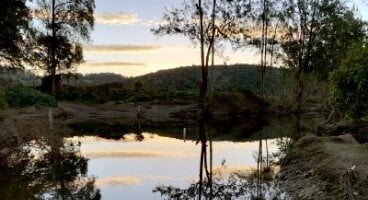Biodiversity & Natural Capital
BIODIVERSITY AND NATURAL RESOURCE MANAGEMENT
Ensuring land and biodiversity health, long-term productivity and growth.
The health and protection of our natural resources is critical to the ongoing health and function of our society. Demands on natural resources are increasing, and there is greater need for more effective management and use of these resources to protect and improve the health of society.
Our natural resource management solutions are essential when Australia is under increased pressure from climate change and water scarcity. Our consultants work closely with national, state and local governments and private landowners to protect and manage our natural resources.



BIODIVERSITY & NATURAL RESOURCE MANAGEMENT
Our expert team consult on a range of issues to help protect and improve the health of environmental assets.

Developing and implementing NRM projects, programs and reforms
Management of our natural resources at landscape, catchment and local scales is complex and requires a deep understanding of natural systems and processes. Our team have extensive experience in the management of natural resources at all scales and across water, biodiversity and soils. We have been around long enough to know what works and what doesn’t. We are absolutely committed to working with landowners and governments to find effective ways to protect our natural resources, maintain and improve productivity and ensure we improve and enrich our society.

The Biodiversity Offsets Scheme
The Biodiversity Offsets Scheme is a transparent, consistent, and scientifically based approach to assessing biodiversity changes and offsetting. A development project may significantly impact biodiversity and implementing the Biodiversity Offsets Scheme aims to ensure no net loss of biodiversity in NSW.

Ecology Services
- Biodiversity Development Assessment Reports (BDARs)
- Ecological Impact Assessment for development and activities
- Environmental Studies for local government rezoning initiatives
- Threatened species assessments
- Strategic invasive weed assessment and control works
- Habitat restoration planning and vegetation management plans
- Pre-clearing surveys, clearing monitoring and wildlife management

Biodiversity Stewardship
- Strategic advice and assessment reports on Biodiversity Offsetting on land asset portfolios
- Connect credit purchasers with credit providers in regional NSW
- Assist with the project management, reporting and on-ground management of your stewardship site

Vegetation, Riparian, Coast and Estuary Management
- Preparation of vegetation and coastal management studies and plans
- Delivery of on-ground works under the new NSW coastal management reforms
- Waterway health and planning assessments
- Acid sulphate soil management and soil erosion mitigation
No video selected
Select a video type in the sidebar.
We are industry approved which means we easily develop pathways to positive outcomes.
OUR CLIENTS
We’re proud to work with a range of clients across various industries and projects.






































































FEATURED PROJECTS
View some of the projects we’ve been working on lately.
CAPABILITY STATEMENT
Solving complex issues for your business.
We are a team of like-minded, motivated and skilled experts with broad knowledge and experience – offering specialist consulting and project services.
.png?width=756&height=470&name=756x470-CapState-Small-CTA%20(1).png)
THE BIODIVERSITY OFFSETS SCHEME
The Biodiversity Offsets Scheme is a transparent, consistent, and scientifically-based approach to assessing biodiversity changes and offsetting. A development project may significantly impact biodiversity and implementing the Biodiversity Offsets Scheme will ensure that no biodiversity change goes unnoticed.
Ensuring land and biodiversity health for long-term productivity and growth
TESTIMONIALS
“I worked with Cindy Liles at WolfPeak, a knowledgeable consultant. Her service is fast and accurate; I never had to check the quality of her work. She even went beyond her responsibilities and visited our office for our face to face IS Rating meeting to provide support”.

"WolfPeak are a choice team to work with. Led by Tim Stubbs, the team successfully won a bid for us to undertake a large re-development project for a community hub. WolfPeak continues to perform like champions, providing us leadership tact as we work together on rebuilding a strong foundation for the Mogo Local Aboriginal Land Council after the bushfires".

“Everyone in the WolfPeak pack consistently make my life easier”.

“I continue to use WolfPeak as my primary service provider for ecological assessments and REF contracts due to their ability to be flexible and respond quickly to our requests. The outputs are of a very high standard, and I continue to recommend to others”.

“I worked with Cindy Liles at WolfPeak, a knowledgeable consultant. Her service is fast and accurate; I never had to check the quality of her work. She even went beyond her responsibilities and visited our office for our face to face IS Rating meeting to provide support”.

"WolfPeak are a choice team to work with. Led by Tim Stubbs, the team successfully won a bid for us to undertake a large re-development project for a community hub. WolfPeak continues to perform like champions, providing us leadership tact as we work together on rebuilding a strong foundation for the Mogo Local Aboriginal Land Council after the bushfires".

“Everyone in the WolfPeak pack consistently make my life easier”.

“I continue to use WolfPeak as my primary service provider for ecological assessments and REF contracts due to their ability to be flexible and respond quickly to our requests. The outputs are of a very high standard, and I continue to recommend to others”.

“I worked with Cindy Liles at WolfPeak, a knowledgeable consultant. Her service is fast and accurate; I never had to check the quality of her work. She even went beyond her responsibilities and visited our office for our face to face IS Rating meeting to provide support”.



Frequently Asked Questions
-
What is a biodiversity credit?
A biodiversity credit is a unit of measurement for a biodiversity impact at a development site or biodiversity gain at a Stewardship site. There are two categories of biodiversity credit: ecosystem credits and species credits.
-
How is the Biodiversity Offset Scheme triggered?
The Biodiversity Offset Scheme can be triggered in four different ways: Impacting vegetation mapped on the Biodiversity Values Map, exceeding the specified clearing threshold, impacts resulting in a significant impact on threatened species or ecological communities, or affecting an Area of Outstanding Biodiversity Value.
-
When do I need an Ecological Assessment?
Ecological Assessments are needed in the Environmental Impact Assessment process in order to gain developmental approval, as required by the NSW Environmental Planning & Assessment Act 1979. Public authorities undertaking works under Part 5 of the Environmental Planning and Assessment Act also require an ecological assessment if they are impacting native vegetation or habitat.
-
What is a Five Part Test of Significance?
The Five Part Test of Significance is prescribed in the NSW Biodiversity Conservation Act 2016 and typically forms part of an ecological impact assessment report. It consists of five questions that are answered and assessed by an ecologist to determine if an action will result in a significant impact on threatened species or ecological communities.
-
What Is Natural Resource Management?
The term “Natural Resource Management” (NRM) describes the responsible use of the world’s primary natural resources, including land, water, air, minerals, forests, fisheries, and wild plants and animals.
These resources offer essential life support in terms of consumption and general welfare services. Environmental processes preserve climate cycles, nutrient recycling, soil health, and air and water purification.
-
What Is Sustainable Management of Natural Resources?
Sustainable management of natural resources is using natural resources to preserve and improve ecosystems and their advantages. It is necessary because it promotes resource management and safeguards the needs of future generations.
Instead of using non-renewable resources like fossil fuels, we can accomplish the same aim by harnessing renewable resources like wind and solar energy and employing services that do not harm the environment as much.
Sustainable resource management will occur if our current consumption rate can be maintained indefinitely without harming the ecosystem.
-
What Does Biodiversity & Natural Resource Management Include?
Ecological, economic, social, and environmental sustainability are all included in natural resource management. For the successful implementation of NRM in these areas, proper oversight, monitoring, and regular evaluation are essential.
Biodiversity is the term used to describe all the diverse types of life you can find in one place. The many plants, animals, microbes, and fungi that make up our physical environment are all part of biodiversity. These various species and critters collaborate in complicated web-like ecosystems to keep things in equilibrium and sustain life.
-
Does WolfPeak do ecological assessments?
At WolfPeak, our team has a wealth of experience managing natural resources of various sizes, including soils, water, and biodiversity. Having been around for a while, we know what works and what doesn’t.
We are fully committed to collaborating with landowners and governments to identify practical solutions for safeguarding our natural resources, sustaining and enhancing productivity, and ensuring the advancement and enrichment of society.
-
Why Choose WolfPeak for Your Natural Resource Management?
At WolfPeak, our team has a wealth of experience managing natural resources of various sizes, including soils, water, and biodiversity. Having been around for a while, we know what works and what doesn’t.
We are fully committed to collaborating with landowners and governments to identify practical solutions for safeguarding our natural resources, sustaining and enhancing productivity, and ensuring the advancement and enrichment of society.

